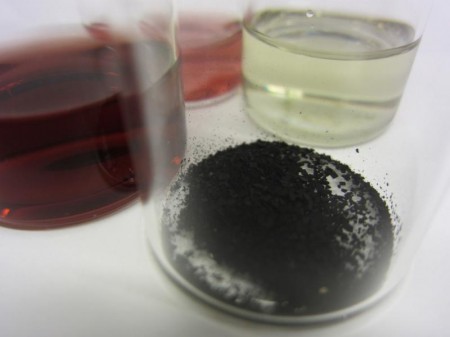Apr
13
CO2 Plus Gold and Copper Equals Methane or Methanol
April 13, 2012 | 2 Comments
Copper – the stuff of pennies and electrical wiring – is also one of the few metals that can turn carbon dioxide into hydrocarbon fuels with relatively little energy. But copper oxidizes easily, turning green and becoming unstable as a catalyst.
It’s long been known a copper electrode stimulated with voltage acts as a strong catalyst, setting off an electrochemical reaction with CO2 that reduces the CO2 to methane or methanol. Researchers around the world have studied copper’s potential as an energy-efficient means of recycling CO2 emissions in power plants. But the oxygen bonds to the copper slowing the reaction and yielding unwanted byproducts such as carbon monoxide and formic acid. It’s been a dead end, until:
MIT’s researchers have come up with a solution that may further reduce the energy needed for copper to convert carbon dioxide, while also making the metal much more stable.
They’ve engineered tiny nanoparticles of copper mixed with gold, which is resistant to corrosion and oxidation. The researchers observed that a minor proportion of gold makes copper much more stable. In the experiments the coated electrodes with the hybrid nanoparticles required much less energy for the engineered nanoparticles to react with carbon dioxide, compared to nanoparticles of pure copper.
The paper detailing the results will appear in the journal Chemical Communications. (Check this link over the coming weeks for a search.)
Co-author Kimberly Hamad-Schifferli associate professor of mechanical engineering and biological engineering at MIT says the findings point to a potentially energy-efficient means of reducing carbon dioxide emissions from power plants, “You normally have to put a lot of energy into converting carbon dioxide into something useful. We demonstrated hybrid copper-gold nanoparticles are much more stable, and have the potential to lower the energy you need for the reaction.”
Hamad-Schifferli explains the team chose to engineer particles at the nanoscale in order to “get more bang for their buck”. The smaller the particles, the larger the surface area available for interaction with carbon dioxide molecules. “You could have more sites for the CO2 to come and stick down and get turned into something else,” she said.
The team settled on gold as a suitable metal to combine with copper mainly because of its known properties. The gold with copper combination has been tried at much larger scales hinting that the oxidation issue could be solved.
To make the nanoparticles, Hamad-Schifferli and her colleagues mixed salts containing gold into a solution of copper salts. They heated the solution, creating nanoparticles that fused copper with gold. Postdoc Zichuan Xu then put the nanoparticles through a series of reactions, turning the solution into a powder that was used to coat a small electrode.
To test the nanoparticles’ reactivity, Xu placed the electrode in a beaker of solution and bubbled carbon dioxide into it. He applied a small voltage to the electrode, and measured the resulting current in the solution. The team reasoned that the resulting current would indicate how efficiently the nanoparticles were reacting with the gas: If CO2 molecules were reacting with sites on the electrode – and then releasing to allow other CO2 molecules to react with the same sites – the current would appear as a certain potential was reached, indicating regular “turnover.” If the molecules monopolized sites on the electrode, the reaction would slow down, delaying the appearance of the current at the same potential.
Over the course of the experiments the team found that the potential applied to reach a steady current was much smaller for hybrid copper-gold nanoparticles than for pure copper and gold – an indication that the amount of energy required to run the reaction was much lower than required when using nanoparticles made of pure copper.
For the future Hamad-Schifferli said she hopes to look more closely at the structure of the gold-copper nanoparticles to find an optimal configuration for converting carbon dioxide. So far, the team has demonstrated the effectiveness of nanoparticles composed of one-third gold and two-thirds copper, as well as two-thirds gold and one-third copper.
The team has given the cost issue some thought and allows that coating industrial-scale electrodes partly with gold can get expensive. However, Hamad-Schifferli points out the energy savings and the recycling potential for the metals in the electrodes may balance the initial costs.
Hamad-Schifferli explains the overall view with, “It’s a tradeoff. Gold is obviously more expensive than copper. But if it helps you get a product that’s more attractive like methane instead of carbon dioxide, and at lower energy consumption, then it may be worth it. If you could reuse it over and over again, and the durability is higher because of the gold, that’s a check in the plus column.”
The other team members are Yang Shao-Horn, the Gail E. Kendall Associate Professor of Mechanical Engineering at MIT, and Erica Lai, class of 2014.
It looks like the combustion effluent of CO2 is going to have value soon.
Comments
2 Comments so far



Okay, so CO2 created by coal fired power plants could become a very sought after biproduct because it could be turned into a valuable fuel for a small investment of energy.
Send a cleaning crew down the the EPA. Someone is going to have to wash down the walls after all those bureaucrats heads Explode!
I hope this can be commercialized. I am sure that private-sector venture capital funds will be interested, if it has come potential.